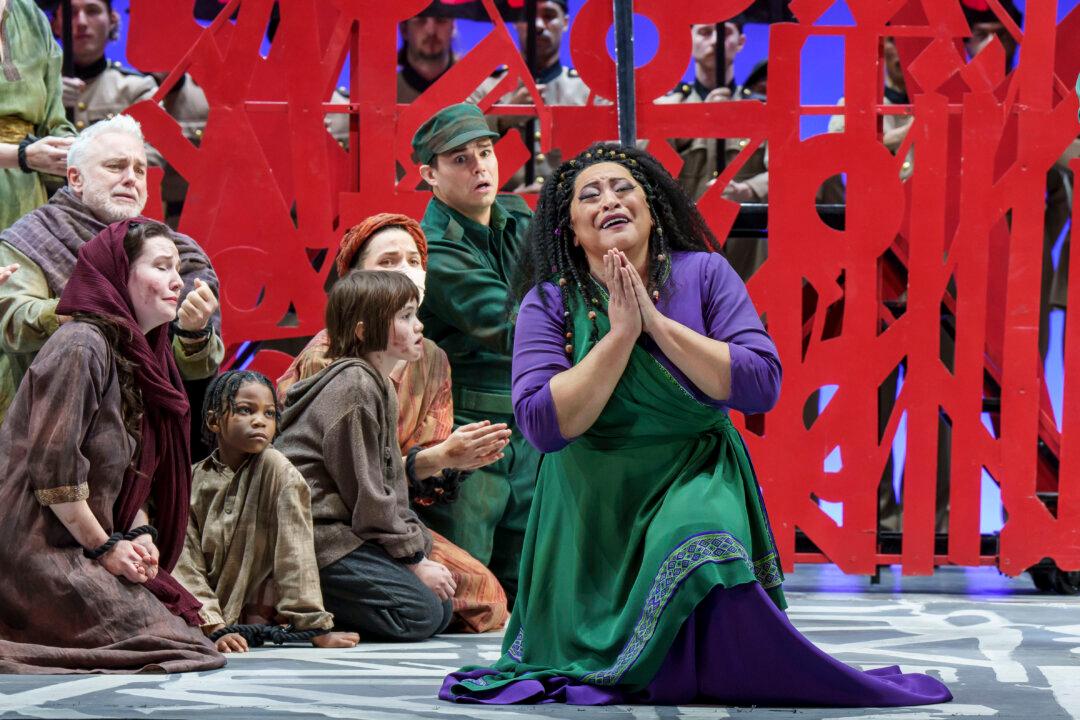CHICAGO—When the Suez Canal opened in 1869, it shortened the route between Europe and India, changing the world overnight. Consequently, the Egyptian capital of Cairo became very important. Italian opera composer Giuseppe Verdi (1813–1901) was asked to write an opera for the inauguration of the brand new theater in Cairo, but he didn’t want to travel to Cairo (Verdi often conducted the opening performance of his operas) and wasn’t interested in composing an opera about Egypt.
The Love Triangle

The opera, set in Egypt’s past, revolves around a desperate love triangle. Radames, the Egyptian general is supposed to marry Amneris, the king’s daughter, but his desire takes an unlikely turn when he brings home an Ethiopian princess, Aida, whom he'd captured and fallen in love with. Of course, when Amneris discovers that her intended is in love with someone else, she becomes jealous and vengeful.
‘New-to-Chicago’ Production
Last presented at the Lyric Opera of Chicago 12 years ago, this revival of Verdi’s enchanting work is not quite up to par with its previous production. With its broad sweep of a fascinating ancient culture, its glorious spectacle, and soaring music, “Aida” is one of the grandest of grand opera, but you would never know it from director Francesca Zambello’s stagecraft.It’s difficult to tell whether the story is taking place in Egypt or in some third-world country. The opera opens not in an Egyptian hall, but in a dark military-style room with shadowy walls, fluorescent lighting, and metallic chairs. Indeed, for those who have seen “Aida” in the past with lavish and exotic sets, Michael Yeargan’s set looks penny-pinching.
The costuming by designer Anita Yavich isn’t much better. She mixes beautiful evening dresses and elegant robes with military khaki-style uniforms, which makes the period and place confusing.
Furthermore, the lush pageantry of “Aida,” which was a staple of the opera is gone. Instead of a triumphal scene, Jessica Lang’s choreography features soldiers marching; the ballet, which has always been stunning, has a group of eight man sporting tank tops that look out of place with one lonely female dancer, Anne O’Donnell Passero, who is decked out in a gorgeous gown.

That said, there is a wonderful climactic “tomb scene” where Aida and Radames promise to be together for eternity. Yet best of all is Verdi’s glorious, triumphant musical score, soaring with delicious power under the baton of Enrique Mazzola conducting the Lyric’s exceptional orchestra. The chorus, led by Michael Black, is also fantastic. And, the ensemble of singers does a fine job of vocalizing and bringing out the best in Verdi’s delectable music.
Soprano Michelle Bradley is convincing as Aida, standing out with a passionate “O Patria Mia,” in which we hear her longing to return home. Tenor Russell Thomas, as Radamés, comes through with palpable sensitivity as a conflicted lover who has sworn loyalty to a system he has begun to question. His velvety tenor is terrific in the difficult aria “Celeste Aida.”

Jamie Barton comes through with a strong mezzo-soprano as the jealous and revengeful Amneris, who is convinced that if she can’t have Radames no one else can. In addition, even though baritone Reginald Smith Jr. has a small role as Amonasro, Aida’s father, his is a charming performance. Other contributors include bass William Clay Thompson as the King, Kathryn Henry as a graceful priestess, and Alejandro Luévanos as the Messenger.
All in all, none of the production’s problems affect Verdi’s spine-tingling music, which, in itself, is the best reason to see this “Aida.”







